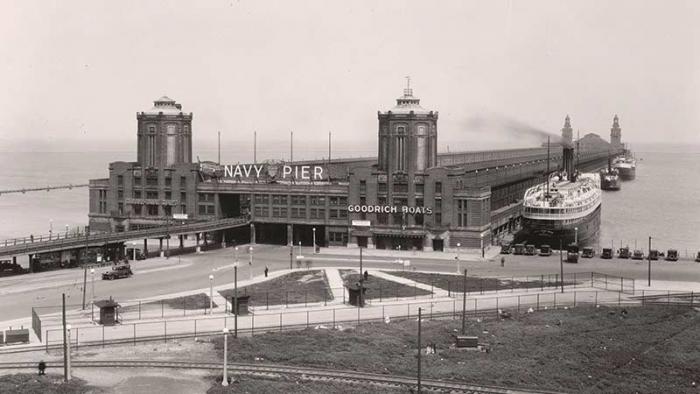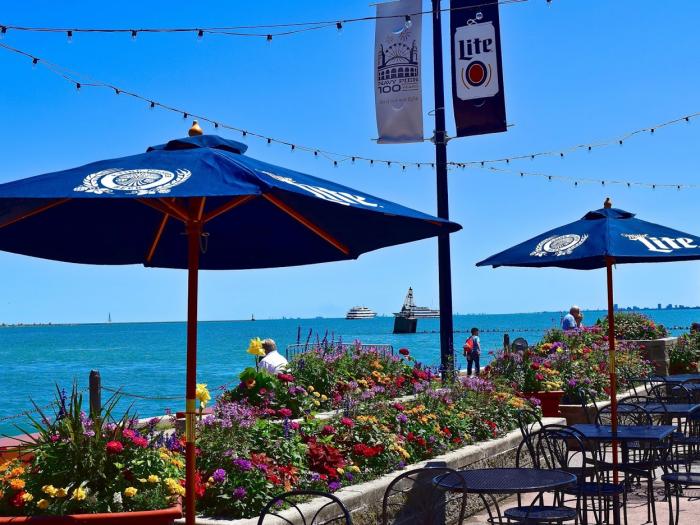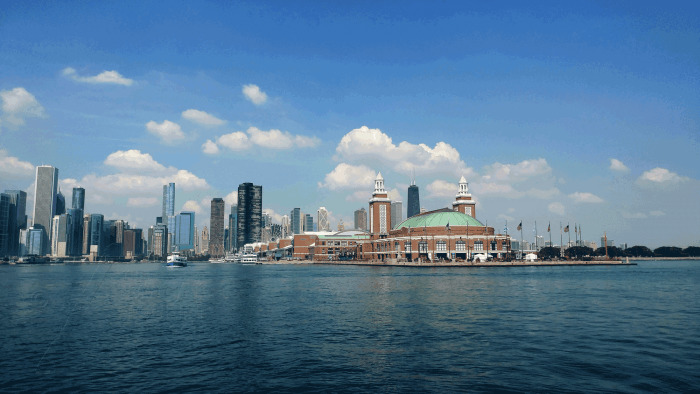The history of Navy Pier began with Daniel Burnham’s Plan of Chicago. From pleasure pier to Navy base to college campus to tourist attraction, it’s a fascinating tale of adaptation.
Please enjoy this excerpt from Living Landmarks of Chicago: Tantalizing tales and skyscraper stories; bringing Chicago’s landmarks to life – an Amazon Bestseller!
Chicago in the early 1900s was a mess, to put it lightly. Despite an official motto of “urbs in horto”—city in a garden—it was anything but. It was crowded. Dirty. Stinky. Think traffic is bad now? Fuhgeddaboudit. So many ships were coming into the Chicago River that you could barely cross it because the bridges were continuously being raised, and there weren’t that many bridges in the first place. The Michigan Avenue Bridge didn’t exist—Michigan Avenue north of the river didn’t even exist. Getting “bridged” was an acceptable excuse for being late to work.
So a group of businessmen got together and made a plan. This plan was a civic ideal that would turn Chicago from a chaotic mess into the City Beautiful. The Second City, reborn from the ashes of 1871, would reinvent itself again. With the World’s Columbian Exposition, Chicago had already proven that it could build beauty out of chaos and structure out of mud, but this time they would make it permanent. They even hired the same man to make it happen.
That man was Daniel Burnham. He’s oft quoted for saying “make no little plans, for they have no power to stir men’s blood,” and while there’s no proof he actually uttered those words, he certainly lived it. His dream of a new city was expansive, majestic, and would transform Chicago forever.
After the 1893 fair, Daniel was in demand as a civic planner. Washington, D.C.; Cleveland, Ohio; and San Francisco, California hired him. So widespread was his fame that he designed plans for Manila and Baguio in the Philippines, too. He was still designing buildings while envisioning these orderly urban areas—it was while he was in Manila that Theodore Thomas cabled Daniel to applaud his design of Orchestra Hall.
History of Navy Pier

On July 4, 1909, the Commercial Club of Chicago unveiled the epically detailed Plan of Chicago, co-authored by Daniel and Edward Bennett. Converting Chicago’s lakefront from an industrial eyesore into a playground that was open to all was a vital piece of that plan. The trick, and this was an ongoing balancing act, was to satisfy the city’s commercial interests with its social. The city that worked also needed to be the city that played.
The plan included the development of five piers in Lake Michigan. Two of those piers would flank the Chicago River. Not only would they greatly reduce the congestion of commercial ships into the river itself, but they would also provide a recreational space.
It was the first time a pier would serve both purposes.
This wouldn’t be easy. Lake Michigan was notorious for creating land along the shore where previously there had been water. In addition to landfill, Grant and Lincoln Parks owed much of their acreage to shifting sands. John Farwell added a pier to his four-acre property at the end of North Avenue in 1866 and ended up with fifteen more acres within six years. And Daniel’s plan called for a pier that would stick more than half a mile into the lake. Make no little plans, indeed.
Daniel died in 1912, but the plan lived on and over the years, pieces of it began to take shape. Municipal Pier #2 was one of the first, and in 1913, the city chose Charles Sumner Frost as the architect. Charles, born in 1856 in Maine, graduated from MIT and worked with Peabody and Stearns in Boston before coming to Chicago in 1882. He partnered with Henry Ives Cobb and helped design the Palmer Mansion, the mock-castle that would drive the wealthy to the north side.
After a decade of solo practice, he joined forces with Alfred H. Granger. From 1898 to 1910, Frost and Granger were the builders of railroad depots—they put up a whopping one hundred and twenty-seven buildings for the Chicago and North Western Railway alone. Of course, it helped that they’d both married daughters of Marvin Hughitt, the railroad’s president. That experience gave Charles a unique perspective on building a space meant to keep people moving.
Charles was in charge of what would go on the pier. The pier itself would be the province of the uniquely qualified Edward C. Shankland. Not only was he the chief engineer of the Harbor and Subway Commission, Edward had also been Burnham’s chief engineer for the World’s Columbian Exposition. The plan he devised to keep the massive pier stable might have seemed like overkill: workers drove more than twenty thousand Oregon timber pilings between twenty and twenty-seven feet down. Steel tie-rods anchored the pilings, which were topped with a concrete foundation that supported the steel columns of the pier’s buildings. A triple row of piles supported concrete dock walls; those were bordered with clay, rock, and sand and were buttressed by loose rock. That thing was not going to move…and it hasn’t.
On top of the pier, Charles created a design that would pull the triple duty of serving freight, passenger, and recreational needs. On the west end, the neoclassical red brick Head House was decorated with terra cotta ornamentation of frogs, turtles, lilies, cattails, sheaves of wheat, and Native Americans. Two towers camouflaged a couple of sixty-thousand-gallon gravity tanks, which would feed the sprinkler system. On the east end, the Terminal Building held the information office, restrooms, first aid, a restaurant, and a rooftop garden. Next to that was a two-story open-air shelter, which connected to the concert hall, a stunning auditorium with exposed radial steel trusses formed in half-arches under a massive dome. Observation towers flanked this end.
In between these bookends, Charles built two sheds, each 2,340 by 100 feet with an 80-foot roadway in the middle. The first floor serviced freight, and the second floor serviced passengers, with a trolley running an elevated interior loop that could drop them straight at their gate. The whole thing was revolutionary, and was so anticipated that Chicagoans held an impromptu celebration: fifty thousand showed up on July 4, 1916, nine days before the official opening, when another twenty-five thousand appeared. And they kept coming, drawn by concerts, picnics, and promenades.
Within a year there was already a hint of its future conversions. When the U.S. entered World War I in 1917, Municipal Pier #2 became a military recruiting and training center, as well as a communication center—one of the east-end towers became a carrier-pigeon station. The pier also housed draft dodgers, and on one productive day, agents staked out both a Chicago Cubs double-header and a Barnum & Bailey Circus performance at the south side’s White City Amusement Park. Between the two events, more than 200,000 young men were questioned and the dodgers were carted off to the pokey on the pier.
Recreational use continued throughout the war, but the 1920s were the pier’s real heyday. While it was still used for freighters, it also became a full-fledged entertainment destination. There were live bands, plays, art exhibits, children’s activities, fireworks displays, and airplane and motorboat races. In 1921, Mayor Big Bill Thompson kicked off the Pageant of Progress, a mini-world’s fair. Over two thousand exhibits drew between one and two million people in a two-week period. It was such a success that they did it again the next year, but by that time the Mayor’s track record of corruption, in addition to a transportation strike and pesky prohibition raids, dropped attendance in half.
Still, the people came. Chicagoans could finally take full advantage of their city’s greatest asset: Lake Michigan. Great Lakes cruise ships and excursion boats to Lincoln and Jackson Parks departed from the pier. The Goodrich Transit Company would ferry your car to Benton Harbor or Mackinac Michigan. There was even a merry-go-round.
However, the automobile revolution was beginning to draw people away from the lake and towards the open road, and trains diverted freight from ships. From 1926 to 1931, steamship passengers dropped from 471,000 to 258,000. During that time, in 1927, Municipal Pier #2 became Navy Pier to honor the Chicagoans and Midwesterners who had served during World War I.
The Depression hit, but the pier adapted. It hosted trade shows, and during the 1933 – 1934 Century of Progress, ferried attendees to the fair. Then, World War II, and Navy Pier lived up to its name. It became a full-fledged Naval Training School, including two makeshift aircraft carriers converted from passenger paddlewheel cruisers. It made sense—Lake Michigan was safe from Axis submarines and bombers. More than 60,000 sailors, including up to 18,000 pilots, trained at Navy Pier, the most famous of which was future president George H. W. Bush.
After the war, the Navy moved out and the pier adapted once again. This time the War Assets Administration moved in and began selling surplus materials at auction. In a particularly odd placement, considering that this structure jutted into the lake, the Chicago Police Department’s Traffic Division opened administrative offices, a garage, and a branch of traffic court. It operated there until 1955.
The end of the war and the passage of the G.I. Bill meant that lots of soldiers could now get a free college education, and boy did they want it. The demand was so great that the University of Illinois opened a branch in the unusual location of Navy Pier. Nicknamed Harvard on the Rocks, students could get a two-year education in arguably the oddest college campus in the country until 1965, when the school moved to Taylor Street.
The school didn’t take up the whole pier, though. There was still plenty of room for other business, especially business that hearkened back to one of the original goals of turning Chicago into a major inland port. As the St. Lawrence Seaway neared completion, a project that would enable vessels to navigate from the Atlantic Ocean to the Great Lakes, Major Richard J. Daley spearheaded a plan to turn Navy Pier into an overseas terminal.
In 1958 the pier underwent a four-million-dollar renovation, adding berthing spaces for two ocean-going ships. The next July, Queen Elizabeth II and Prince Philip followed the new route and stopped for a quick thirty-one-minute tour of the pier’s International Trade Fair. At first it seemed like Chicago could become an international port, and in the mid-1960s, more than 250 ocean liners docked at the pier. By 1974, however, there were only twenty.
These were tough years. McCormick Place Convention Center had opened in 1961 and taken away most of the trade shows that kept the pier afloat. The only respite was when the competition caught fire in 1967 and conventioneers had no choice but to return to the dilapidated, weather beaten, stripped down location. Things looked bad, but once again, Navy Pier rallied. This time, it was to celebrate the country’s bicentennial. The city began a massive restoration, including landscaping and adding solar energy to heat the east buildings.
In 1977, the City of Chicago declared Navy Pier a Chicago Landmark, and the following year it hosted the first Chicagofest. For the next four years, Chicagofest brought entertainers as diverse as Frank Sinatra, Kool and the Gang, Alice Cooper, and the Chicago Symphony Orchestra to Navy Pier. It would later become the Taste of Chicago.

Something was still missing, though. It was time to take a hard look at this big idea that had started as both a commercial and a recreation center. The solution was another renovation, one that would cement its status as a tourist destination and would reflect many of the experiences that people enjoyed during its golden age of the 1920s. The terminal sheds were destroyed; in their place, Festival Hall, Crystal Gardens, restaurants and shops and kiosks, a park with mini-golf and flying swings and towering above it all, a 146-foot-tall Ferris Wheel paying homage to Daniel Burnham’s 1893 World’s Fair. Summer fireworks blasted every Wednesday and Saturday to music. Chicagoans could once again take pleasure cruises. Concerts returned to the auditorium. The former Head House became home to the Chicago Children’s Museum. Festival Hall drew trade shows and the Winter Wonderfest, and in 1999, the Chicago Shakespeare Theatre enticed fans of the stage.
It worked. The transformation was wildly successful, but many locals claimed it wasn’t enough—even though they still came by the millions. Less than twenty years after that massive renovation, Navy Pier reinvented itself once again.
One thing that had been missing from the pier was, with the exception of the enclosed Crystal Gardens, any reference to Urbs in Horto. It had always been a concrete amusement park. This time around, it would be a softer, gentler, greener destination. Trees would line the dock and an undulating wave wall softened the hardscape and directed eyes to the new, taller Centennial Wheel and its climate-controlled gondolas. People could walk right up to the edge of the pier, giving them closer access to the water. Another thing that had been missing was the local feel. This time around, they recruited local restaurateurs. The pier also went the polar opposite of the Prohibition-era heyday and strolling with adult beverages in hand became acceptable—née, encouraged. When it reopened in 2016, Navy Pier’s one-hundred-year anniversary, 9.3 million people decided that hey, maybe this was a pretty grand place after all.
Municipal Pier #2 Today

Navy Pier continues its early promise as one of Chicago’s most popular, and free, destinations for a multitude of reasons, including its continued renovations. In 2020, Offshore opened, making Navy Pier the site of the World’s Largest Rooftop Bar, according to the Guinness Book of World Records, and in 2021, Sable at Navy Pier became the landmark’s first hotel.
Learn all about Navy Pier today
Navy Pier has been repurposed, recycled, reinvented, and reinvigorated. It’s been home to soldiers, prisoners, and students. It’s been a driver of commerce, an innovator of entertainment, and a neglected by-product of happier times. Now, it’s not only a reminder of what was, it’s a vivid display of what happens when you make big plans.
For more information, visit navypier.org.
